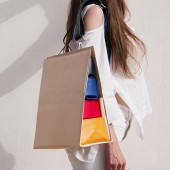
| THE AWARD |
| CATEGORIES |
| REGISTRATION |
| SUBMIT YOUR WORK |
| ENTRY INSTRUCTIONS |
| TERMS & CONDITIONS |
| PUBLICATIONS |
| DATES & FEES |
| METHODOLOGY |
| CONTACT |
| WINNERS |
| PRESS ROOM |
| GET INVOLVED |
| DESIGN PRIZE |
| DESIGN STORE |
| THE AWARD | JURY | CATEGORIES | REGISTRATION | PRESS | WINNERS | PUBLICATIONS | ENTRY INSTRUCTIONS |
Switchbag Backpack by Stéphanie Branco |
Home > Winners > Design #151953 >Interview |
 |
|
FS: What is the main principle, idea and inspiration behind your design?
SB: SwitchBag is a multifunctional marvel, seamlessly transforming from a backpack to an office, a nomadic sanctuary, a decorative piece, or an organizer, effortlessly adapting to any setting. Crafted in response to the pandemic's impact, it serves as a reflection of human complexity and addresses mental health concerns. Its exterior, characterized by minimalism and tranquility, stands in stark contrast to the vibrant and imaginative interior, symbolizing the diverse facets of our personalities. Inspired by both architecture and Mondrian's artistry, the SwitchBag's magnetized compartments reveal miniature worlds within, echoing the mystical energies of nature and the universe. This versatile companion embodies resilience, gracefully transitioning between roles to meet the demands of diverse environments. With detachable interior boxes featuring magnetic attachments, users can customize and rearrange the bag to suit their needs, with the added option of using these boxes as decorative accents. Handcrafted using the "saddle stitch" technique and upcycled leather sourced from luxury tanneries, the SwitchBag not only exemplifies sustainability but also exudes artisanal quality and attention to detail.
FS: What has been your main focus in designing this work? Especially what did you want to achieve?
SB: I envisioned an object that not only organizes people's lives but is also a versatile hybrid, adaptable to modern times and capable of performing multiple functions.
FS: What are your future plans for this award winning design?
SB: Future plans cannot yet be revealed but I can say that they go through several very exciting collaborations and plans.
FS: How long did it take you to design this particular concept?
SB: From research and concept to the final product, the process took around eight months. Numerous prototypes were created to achieve the perfect shape and ideal interior compartments. Transforming such a geometric object into a bag was challenging; it required extensive 3D modeling and 2D molding before moving on to leather.
FS: Why did you design this particular concept? Was this design commissioned or did you decide to pursuit an inspiration?
SB: It was an object developed internally in the studio and I wanted to address a theme that, for many years, was considered taboo but is now being discussed more openly: mental health. During Covid, many people struggled with isolation, depression, and inner demons that had previously been dormant in their daily lives. Often, psychological issues are difficult to detect, and some individuals can hide them from family and friends. The Switchbag embodies these two facets: an exterior that appears plain and an interior that is colorful, adaptable, and complex.
FS: Is your design being produced or used by another company, or do you plan to sell or lease the production rights or do you intent to produce your work yourself?
SB: Currently, I am producing the designs in-house at the studio, aiming for a customizable product available in very limited editions. One of the core principles of ASA Leather Work is to create small series of products made to order, allowing customers to participate in the design and manufacturing process. This approach ensures close interaction with customers and emphasizes handcrafted quality.
FS: What made you design this particular type of work?
SB: The backpack is one of the most commonly used items today. We often carry our essentials, including our PC, on our backs, essentially bringing our "life" with us. This is especially true for women. With its interior compartments, this backpack allows you to organize items by category, making them easier to find. Additionally, since these compartments are aesthetically pleasing, you can simply place them on your desk without having to unload everything.
FS: Where there any other designs and/or designers that helped the influence the design of your work?
SB: The design draws inspiration from my background in architecture and architects like Le Corbusier. I aimed to create a minimalist exterior with perfectly fitting, geometrically precise internal compartments—a kind of internal Lego. Additionally, I was greatly influenced by Mondrian's geometric and colorful paintings. The incredible harmony in Mondrian's work, often reflecting the Fibonacci sequence, has always fascinated me and inspired the backpack's design.
FS: Who is the target customer for his design?
SB: This product is designed for urban, nomadic, and creative individuals aged 35 to 45, both women and men, who travel frequently and need to keep their belongings well-organized and easily accessible. They have a keen interest in interior design and art, enjoy experiential travel, and lead active, curious lives. They appreciate unique, personalized products that reflect their identity. They seek out emerging designers and highly value sustainability and the quality of handcrafted items made exclusively for them.
FS: What sets this design apart from other similar or resembling concepts?
SB: I believe its uniqueness lies in its adaptability and modularity. Each inner box can be moved and repositioned using magnets, and their colors help categorize contents, making it easier to find what you need. Additionally, these boxes are designed to be used individually without having to remove their contents, doubling as decorative objects. Imagine these colorful boxes displayed on your desk—they're simply gorgeous!
FS: How did you come up with the name for this design? What does it mean?
SB: The name of the design reflects the modularity of the boxes, which can be moved and rearranged to "switch" the shape of the backpack. Additionally, "switch" signifies a shift in consumption habits, embracing slow fashion and made-to-order products. This approach contrasts sharply with the fast fashion prevalent today.
FS: Which design tools did you use when you were working on this project?
SB: I like to begin with a concept or topic I want to explore and start sketching ideas in a notebook. The next phase involves 3D modeling, which serves as both a research and work tool for me. Once I achieve the desired result, I create a 2D mold and make a prototype, first using cardboard and then leather. After refining all the details, I craft the final product, which is entirely hand-stitched and handmade.
FS: What is the most unique aspect of your design?
SB: I think what sets it apart is its ability to blend an ancient, entirely manual technique with a modern design object. Ultimately, this item symbolizes the ability to preserve tradition and heritage, breathing new life into an object that caters to contemporary lifestyles and workspaces, despite the inherent challenges. Moreover, it's not just functional; it doubles as a decorative piece.
FS: Who did you collaborate with for this design? Did you work with people with technical / specialized skills?
SB: The design was evolving with inputs of designers, architects, friends and family. I believe that constant bainstorming and asking for opinions from people who are not directly linked to the area is surprising and very useful when we are developing a product.
FS: What is the role of technology in this particular design?
SB: Technology played a crucial role in the development of this product. Due to its highly structured geometric shape, 3D modeling was essential, enabling the object to evolve and anticipate and solve potential problems before production began. All 2D molds were derived from this 3D model, ensuring a higher level of precision and minimizing margins of error.
FS: Is your design influenced by data or analytical research in any way? What kind of research did you conduct for making this design?
SB: No.
FS: What are some of the challenges you faced during the design/realization of your concept?
SB: The primary challenge was transforming a highly precise and geometric 3D design into a handmade product using "living" leather—a material with its own unique characteristics and behaviors. Additionally, incorporating magnets into the design to ensure invisible fastening posed another significant challenge. This necessitated numerous tests, errors, and adjustments. Sometimes, achieving a minimalist design requires extensive study and research.
FS: How did you decide to submit your design to an international design competition?
SB: I decided to enter my design into an international competition to expand its reach and showcase the manual technique behind its creation. Winning an international award would serve as a quality endorsement for our small brand, opening doors to new international markets. The exposure generated significant interest, leading to several partnership and collaboration requests.
FS: What did you learn or how did you improve yourself during the designing of this work?
SB: This design has unlocked a wide range of possibilities for the development of future objects and collections. It has paved new paths and introduced a highly personal language for the ASA Leather Work brand. I gained invaluable insights throughout the product development process, particularly in witnessing its transformative journey towards its final form.
FS: Any other things you would like to cover that have not been covered in these questions?
SB: I just want to thank my family and friends for their support, without whom this award would not have been possible.Thank you!
FS: Thank you for providing us with this opportunity to interview you.
A' Design Award and Competitions grants rights to press members and bloggers to use parts of this interview. This interview is provided as it is; DesignPRWire and A' Design Award and Competitions cannot be held responsible for the answers given by participating designers.
| SOCIAL |
| + Add to Likes / Favorites | Send to My Email | Comment | View Press-Release |





